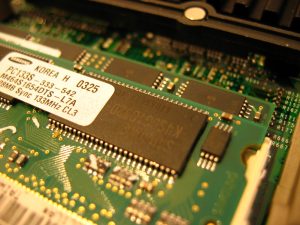December 16, 2018
Upgrading your older Mac: Adding more RAM and/or a solid state drive

Solid state drives (SSDs) are have no moving parts and are faster than traditional hard drives.
Here we go again – a question I am asked on a weekly basis – “Is it worth it to upgrade the RAM and internal hard drive in my old computer?”
My answer? It depends.
One issue is the age of the hardware. Some older Macs (I’m not going to get into tech specs and all that geekspeak here) simply are unable to run newer versions of the Mac OS (Mojave, High Sierra and Sierra), which can cause issues, such as not being able to support a browser that is secure enough to access certain sites – financial institutions, for example.

In the “good old days,” Apple was stingy when it came to RAM.
But if you have cleared that hurdle, you have the issue of your RAM and hard drive. Today, Apple has made it (for the most part) impossible to upgrade these items, so when you DO buy new, make sure you get what think you might need for the future.
Back in the day (probably pre-2012), Apple was notoriously Scrooge-like when it came to the amount RAM in your computer when you bought off the rack. But no harm, no foul, it was inexpensive (and simple) enough to buy from a third-party, and so for a few bucks and a few minutes of your time, you were all set. So, if an infusion of RAM might solve your issues, go for it. It’s dirt cheap these days (gone are the rumors of shortages) and it’s easy to install. Just go on YouTube or consult an expert. And that would be me.
The issue of replacing your standard hard disk drive (HDD) with a solid-state drive (SSD) will no doubt speed things up in your computing life. HDDs have moving parts (an arm that reads a spinning platter), as opposed to SSDs, which have no moving parts. BUT – there are a few things that you have consider before ripping out your old school HDD and popping in an SSD. These are:
- Cost. HDDs are dirt cheap in the big scheme of things, and SSD prices are going down. But in 2018, you’re not going to get the same capacity for the same price.
- Capacity vs cost. Today, a 1TB 2.5” internal HDD is just south of $50; plan on paying about three times that for a same capacity SSD. So, chances are that you will be less capacity when you upgrade. But then again, that gives you a chance to archive (or trash) unused data.
- Future plans. Are you planning on buying a new computer in the next six to twelve months? Then maybe don’t bother upgrading. But if you plan on sticking it out and fighting the inevitable until you can’t, then you might want to lay down the old credit card and go for new.
- More costs. Replacing the hard drive in a MacBook Pro is pretty simple; an iMac, not so much. Which means you’re going to have to pay somebody to perform the operation. Plus, you’ll have to buy an additional mounting bracket, which is under $20.
- Yet more costs. Finally, unless you can figure it out yourself, you’re going to need somebody to install the Mac OS on the new SSD and migrate your data over. And if you plan on performing a “clean installation,” i.e., not dragging old garbage system files over (recommended), then that’s even more professional time you have to pay for.
Bottom line: I use the old car and replacing the transmission analogy here; at what point is it better to forget the idea of putting money into the old as opposed to spending on the new? (Saying “throwing good money after bad” is an inexcusable cliché!) You’re going to have to do your cost analysis homework!
